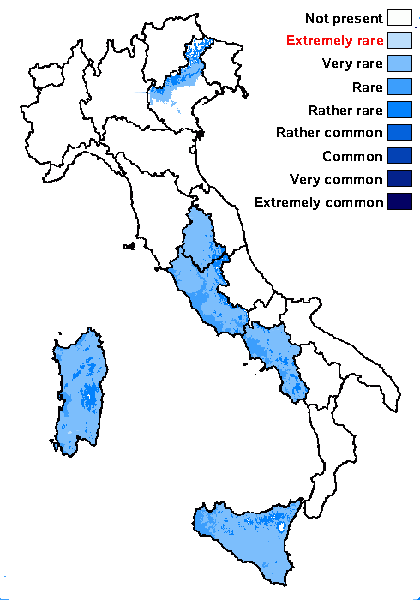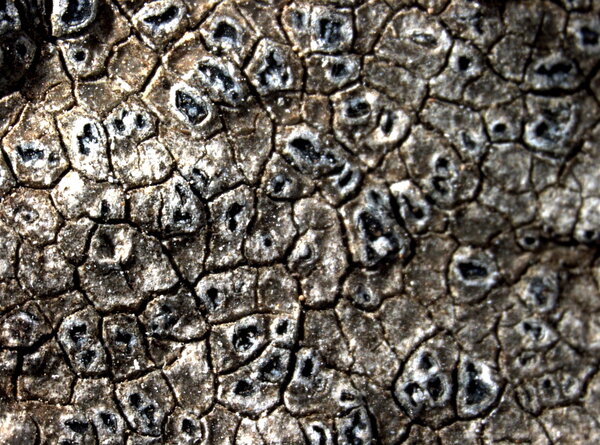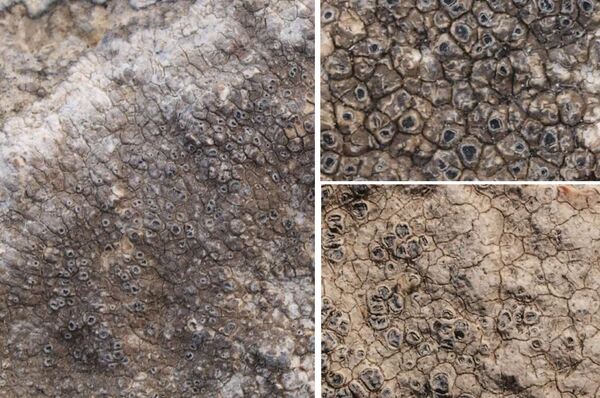Circinaria reagens (Zahlbr.) A. Nordin
in Roux & al., Bull. Soc. linn. Provence, 67: 179, 2016.. Basionym: Lecanora calcarea f. reagens Zahlbr. - Österr. bot. Z., 59: 501, 1909.
Synonyms: Aspicilia calcarea var. reagens (Zahlbr.) Szatala; Aspicilia nicaeensis B. de Lesd.; Circinaria calcarea var. reagens (Zahlbr.); Pachyospora viridescens var. calcarea A. Massal.
Distribution: N - Ven. C - Umb (Genovesi & Ravera 2001, Ravera & al. 2006), Laz, Sar. S - Camp (Aprile & al. 2003b, Nimis & Tretiach 2004, Garofalo & al. 2010), Si.
Description: Thallus crustose, episubstratic, white to brown-grey, rimose-areolate to areolate, 0.25-0.8 mm thick, sometimes delimited by a dark, more or less zoned prothallus, forming more or less orbicular patches. Areoles angular, smooth, the peripheral ones often longer than wide and radially arranged. Cortex brownish in upper part (with the Subdepressa-brown pigment), not entirely filled with crystals; algal layer 40-55 µm thick; medulla white, 0.25-0.3 mm thick, I-. Apothecia cryptolecanorine-aspicilioid, immersed, 1(-4) per areole, round or slightly irregular in size and shape, from punctiform to slightly elongate, 0.2-0.8 mm wide, with a concave to flat, black, sometimes slightly blue-pruinose disc, and a 0.05-0.15 mm thick, chalky-white, slightly raised, finally often excluded thalline margin. Thalline exciple corticate, the outer part with the Subdepressa-brown pigment; proper exciple very thin, colourless; epithecium olive-green, N+ brighter green, K+ brown; hymenium colourless, 100-120 µm thick, inspersed, I+ blue soon turning red-brown; paraphyses septate and anastomosing, sometimes moniliform in upper part; hypothecium colourless. Asci (2-)4-spored, the thin outer coat K/I+ blue, the wall and apical dome K/I-. Ascospores 1-celled, hyaline, broadly ellipsoid to subglobose, 18-30 x 14-28 µm. Pycnidia immersed, appearing as black dots. Conidia (5.5-)7-13.5 x (0.5-)1(-1.5 µm). Photobiont chlorococcoid. Spot tests: thallus K+ yellow turning red (needle-like crystals) or K+ yellow then sometimes orange-brown, C-, KC-, P+ yellow-orange. Chemistry: norstictic acid and stictic acid in variable amounts, aspicilin.
Note: on exposed calcareous rocks; according to Roux et al. (2016) this is a good species; it is apparently most frequent in the mountains of Central and Southern Italy.
Growth form: Crustose
Substrata: rocks
Photobiont: green algae other than Trentepohlia
Reproductive strategy: mainly sexual
Commonnes-rarity: (info)
Alpine belt: absent
Subalpine belt: absent
Oromediterranean belt: absent
Montane belt: rather rare
Submediterranean belt: very rare
Padanian area: absent
Humid submediterranean belt: very rare
Humid mediterranean belt: rare
Dry mediterranean belt: very rare

Predictive model
Herbarium samples
Growth form: Crustose
Substrata: rocks
Photobiont: green algae other than Trentepohlia
Reproductive strategy: mainly sexual
Commonnes-rarity: (info)
Alpine belt: absent
Subalpine belt: absent
Oromediterranean belt: absent
Montane belt: rather rare
Submediterranean belt: very rare
Padanian area: absent
Humid submediterranean belt: very rare
Humid mediterranean belt: rare
Dry mediterranean belt: very rare

Predictive model
| Herbarium samples |
 Index Fungorum
Index Fungorum
 GBIF
GBIF





